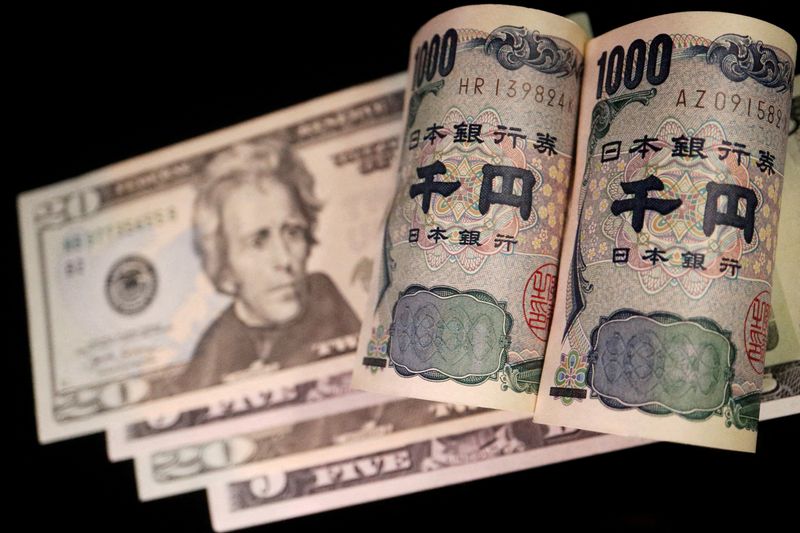Forex
Dollar rock solid as benchmark Treasury yield passes 5%, yen in focus


© Reuters. FILE PHOTO: Banknotes of Japanese yen and U.S. dollar are seen in this illustration picture taken September 23, 2022. REUTERS/Florence Lo/Illustration/File Photo
By Vidya Ranganathan and Alun John
SINGAPORE/LONDON (Reuters) -The moved above 5% on Monday, keeping the dollar supported across the board but without pushing it much higher, while earlier in the day Japan’s yen weakened briefly past the 150-per-dollar level.
Investors are waiting for several events this week, including a European Central Bank meeting, and the release of U.S. GDP data and the Federal Reserve’s preferred inflation gauge.
But the main news on Monday was the yield on 10-year U.S. Treasuries reaching as high as 5.021%, the latest stage of a relentless sell-off in government bond markets, driven by investors accepting central banks will keep rates persistently high, particularly in the United States, an increase in supply of bonds and widening term premia.
Besides that, the risk of Israel’s war on the Islamist group Hamas becoming a wider regional conflict is keeping markets on edge, as Israeli air strikes battered Gaza early on Monday, and the United States dispatched more military assets to the region.
The was steady at 106.1, with the euro up 0.1% at $1.06075, and sterling flat at $1.2170.
Even though it hasn’t risen lockstep with yields, the dollar has been underpinned by the steady rise in yields at the long end of the U.S. Treasuries curve.
Since mid-July, the trade-weighted dollar index is up 6.7% but has been nearly steady this month.
“On paper, it should be a good week for the dollar. US GDP should come in at over 4% and the Fed’s preferred measure of inflation should still be running hot,” said Chris Turner, ING’s global head of markets.
“In Europe, PMIs and the ECB bank lending survey should show an economy mired in stagnation, if not recession.”
Barclays analysts were less sure the dollar had much further to go, however, pointing to stretched long dollar positioning and a smaller likelihood of further rises in long-dated yields without a reassessment of the Fed’s rate outlook.
The Japanese yen last traded at 149.95 per dollar, after briefly easing early on Monday to 150.14, a level last seen on Oct. 3 when traders suspected the Bank of Japan (BOJ) intervened to nudge it back to the stronger side of 150.
The BOJ’s money market data later suggested that the yen’s sudden strengthening was most likely not the product of official Japanese intervention.
Masafumi Yamamoto, chief currency strategist at Mizuho Securities in Tokyo, said it seemed like a set of investors were betting the BOJ would defend the 150 level, even as others saw rising U.S. yields as a reason to keep pushing the dollar up.
“Potentially there are two camps out fighting around 150, so that’s why dollar-yen doesn’t move from here,” Yamamoto said.
While there was some speculation the BOJ might once again tweak its yield-curve policy band at a scheduled policy review next week, the BOJ had also shown it would not let domestic yields rise sharply, he said.
The recent surge in global interest rates is heightening pressure on the BOJ to adjust its bond yield control stance next week, with a hike to an existing yield cap set just three months ago being discussed as a possibility, Reuters reported on Monday.
The ECB meets on Thursday, and a poll by Reuters shows while it is done raising rates it won’t begin easing until at least July 2024. It raised its key interest rates by 25 basis points in September.
However, in more positive news for the European common currency, on Friday S&P upgraded Greece’s credit rating to investment grade, the first of the “big three” ratings agencies to do so since the country’s debt crisis erupted in 2010.

 Forex3 years ago
Forex3 years agoForex Today: the dollar is gaining strength amid gloomy sentiment at the start of the Fed’s week

 Forex3 years ago
Forex3 years agoUnbiased review of Pocket Option broker

 Forex3 years ago
Forex3 years agoDollar to pound sterling exchange rate today: Pound plummeted to its lowest since 1985

 Forex3 years ago
Forex3 years agoHow is the Australian dollar doing today?

 Cryptocurrency3 years ago
Cryptocurrency3 years agoWhat happened in the crypto market – current events today

 World3 years ago
World3 years agoWhy are modern video games an art form?

 Commodities3 years ago
Commodities3 years agoCopper continues to fall in price on expectations of lower demand in China

 Economy3 years ago
Economy3 years agoCrude oil tankers double in price due to EU anti-Russian sanctions





















